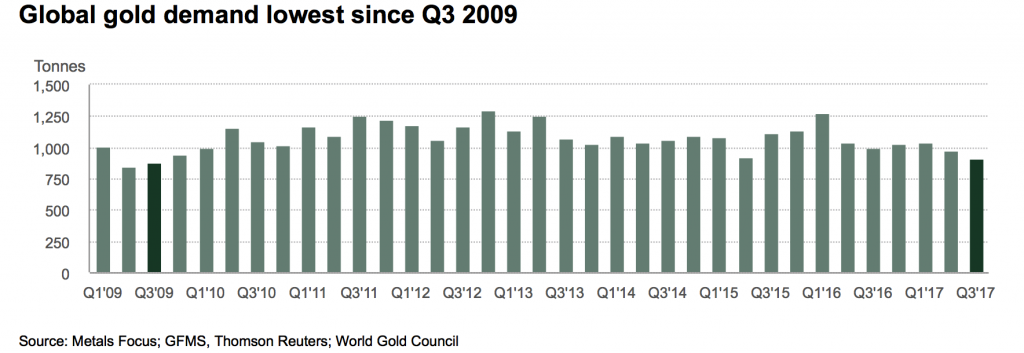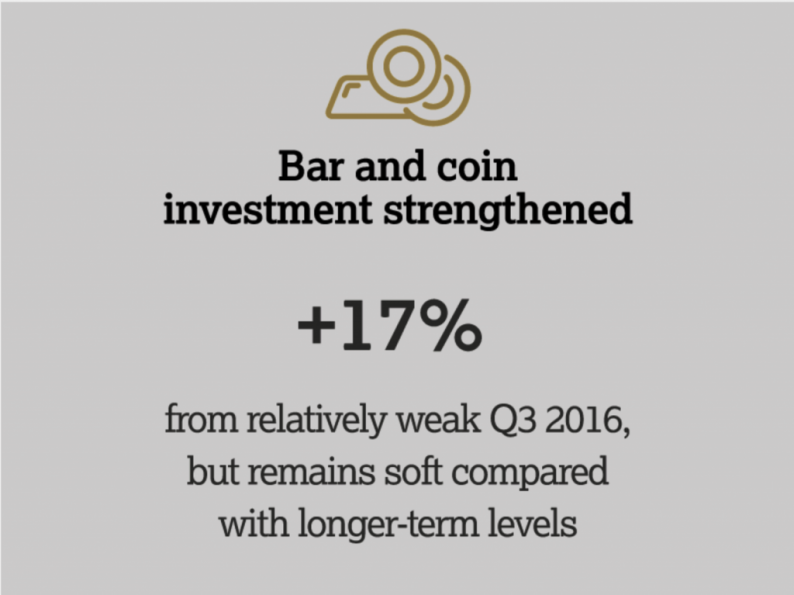– Gold coins and bars saw demand rise 17% to 222t in Q3, driven largely by China
– Chinese investors bought price dips, notching up fourth consecutive quarter of growth
– Jewellery, ETF demand fell while gold coins and bars saw increased demand
– Central banks bought a robust 111t of gold bullion bars (+25% y-o-y)
– Russia, Turkey & Kazakhstan account for 90% of 111t of central bank demand
– Turkey increased gold purchases and saw broad-based physical gold demand
– Gold demand in Q3 at eight-year low as ETF inflows slowed sharply
– Gold demand saw 9% year-on-year (y-o-y) drop in to 915 tonnes (t)
– Total global gold supply fell 2% in Q3

By first impressions, the latest World Gold Council report could make for pretty dismal reading if one were to consider the headlines that followed its release.
Much of the focus was on the fact that record and reported gold demand was at its lowest last quarter since Q3 2009 and down 9% year-on-year.
This was predominantly down to ETF demand which fell from the very high levels seen last year. ETF gold holdings climb by just 18.9t and jewelry demand which fell by 3%.

When one looks at the real gold investment demand which was strong in both areas – demand for gold coins and bars and central bank demand – then they might have cause to start feeling more positive again.
Chinese demand is firmly back with a bang. Chinese investors bought on price dips, bringing a fourth consecutive quarter of growth. This contributed to a 17% rise in Q3 in gold coins and bar demand.
Physical gold investors weren’t the only ones picking up the pace. 111t of central bank demand marked Q3 bringing total reserve demand to nearly 290t for the year to date. 90% of this demand was thanks to Russia, Turkey, and Kazakhstan.
These figures don’t really say much at face value. For example, ETF and jewelry numbers contributing to the 8 year low in gold demand suggest those avenues of investment have fallen out of favor.
However, as with the increase in physical gold investment demand and central bank demand, there is a lot more to the figures than the headlines might initially suggest.
ETF demand to blame?
The headline of the WGC report reads: ‘Gold demand in Q3 at eight-year low as ETF inflows slowed sharply’. Most readers would take from this the first part – gold demand down.

However, ETF demand was merely down not negative. Outflows did not exceed inflows, growth merely slowed as holdings only increased by 18.9t.
This is not a new phenomenon or one that was last seen only back when gold demand levels were so low. In fact, we would be wise to consider the levels of outflows 2011 when the gold price was low and gold numbers were only supported by Chinese buying. Since then ETF demand has recovered.
It might also be worth noting if the lack of interest in ETFs this quarter is a statement about concerns regarding the inherent risk in both the economy and the structure of ETFs.
As both the political and financial systems appear to be inherently weaker than say a year ago investors will be starting to question to safety of their chosen asset allocations.













Leave A Comment